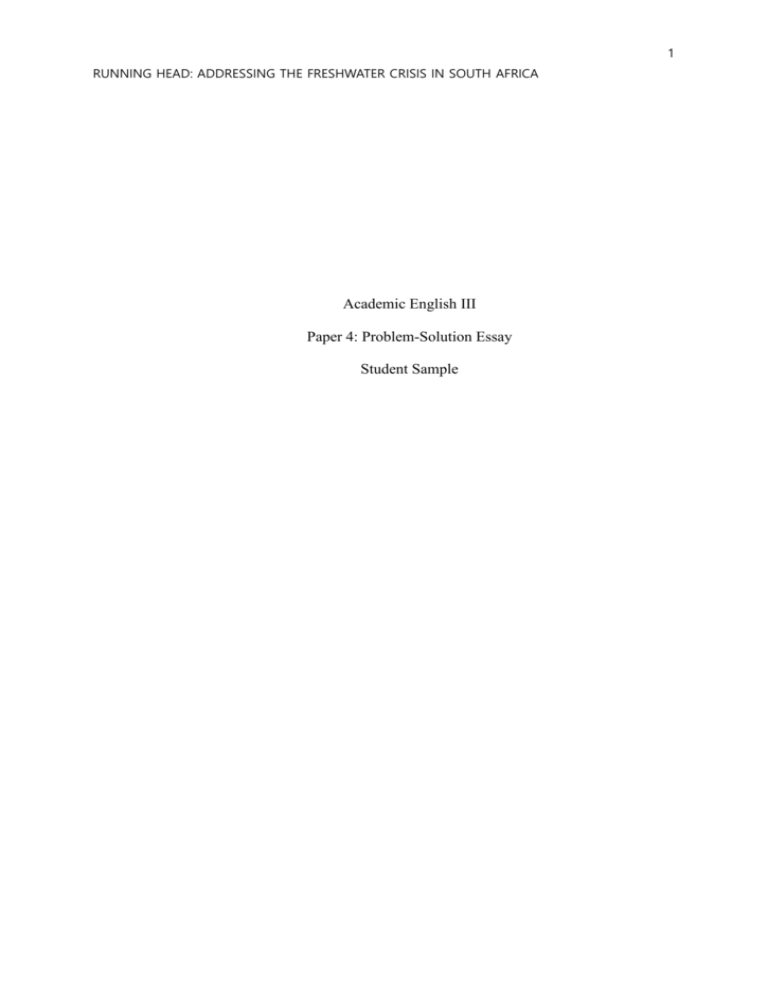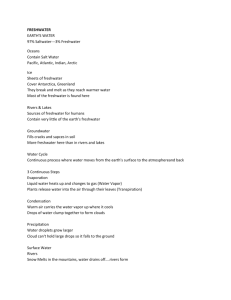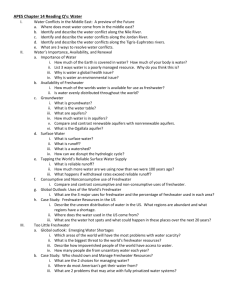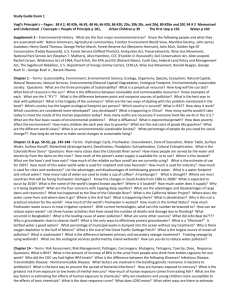problem solution student sample report (1)
advertisement

1 RUNNING HEAD: ADDRESSING THE FRESHWATER CRISIS IN SOUTH AFRICA Academic English III Paper 4: Problem-Solution Essay Student Sample 2 RUNNING HEAD: FRESHWATER CRISIS Introduction Sudden growth in world populations, followed by increased agricultural and industrial production, is straining existing water supplies worldwide. Recent and drastic changes in climate only worsen the problem. According to the Water Resources Group, global demand for water will outpace supply by 40 percent within the next twenty years (Water Resources Group, 2012). The situation varies depending on the country, though: many people in the United States are not even aware of this freshwater crisis, whereas twenty-two countries in Africa are deprived of water that is safe to drink (Lane-Miller, 2004). Among all the regions in the world, South Africa is in the direst situation. Though South Africa has one of the cleanest water systems in the world (IRIN, 2009), lack of sanitation and accessibility is killing numerous South Africans with dehydration, malnutrition and water borne disease. The pain that is currently being inflicted upon people in South Africa can be eased, however, by the government carrying out dam projects and fixing problems in infrastructure. Freshwater Crisis in South Africa – The Situation Freshwater crisis is a worldwide problem, like a comet that is slowly but surely approaching Earth, but South Africa is being especially tormented by it. Millions of people in South Africa lack access to flush toilets and piped water and half the municipal water supplies are contaminated by a large amount of bacteria such as the deadly E. coli bacteria; consequently, the threat of water borne disease is increasing continually (IRIN, 2009). This is a natural result of the limited water reserves of South Africa. The country is one the driest on earth; its average rainfall is about 18 inches a year, whereas the world average is 34 inches a year (Basson, 2011). Figure 1 illustrates the low levels of rainfall in South Africa, showing the mean annual freshwater runoff across the country. Aside from a small area in the southeast, most of South Africa averages a mere 25 - 60mm of freshwater runoff from rain annually. It has no navigable rivers, and the 3 RUNNING HEAD: FRESHWATER CRISIS combined flow of all its rivers is less than half that of the Zambezi River, the closest large river to South Africa. To make the situation even worse, the local geology is comprised of hard rocks, which means there are few exploitable aquifers, and the country’s numerous artificial lakes have a high evaporation rate (Brulliard, 2010). Figure 1. Mean annual freshwater runoff in South Africa (mm/year) Note: Adapted from “South Africa’s water conundrum”, by N. Bruilliard, 2010, Global Post. Copyright 2010. Adapted with permission. Solutions for the Fresh Water Crisis Solution 1 - Dams One solution that could solve this problem is building dams. A dam is good for controlling water supply and irrigation, flood control and navigation, and is important for developing and managing water resources (ICOLD, n. d.). Therefore, the South African government could invest money and build well-planned and constructed dams to store water 4 RUNNING HEAD: FRESHWATER CRISIS effectively. However, some down-sides of this solution must also be considered. Firstly, the average cost of building a dam is 690 million USD. This would be an immense burden on the South African economy which is already weak from suffering under agricultural stagnation caused by the water shortage. Secondly, building dams will have consequences downstream. Communities downstream could be deprived of water, which would lead to low supplies of fish and nutrients offered by floodplain ecosystems (International Rivers, n. d.). Solution 2 – Improving Ground Water Management Consequently, a more desirable solution is necessary, such as improving the poor groundwater management in the country. Surface water sources are too often highly polluted, so groundwater, a reliable source that is naturally protected from bacterial contamination, is a better resource to tap and draw clean water from (Awuah, 2009). South Africa currently draws and consumes approximately 6 percent of groundwater only; it neither develops nor manages its groundwater resources properly. The South African government needs to rebuild the rusty, outdated groundwater well infrastructure that is spread throughout the country, develop production boreholes over the aquifer system, and repair failing pumps that barely pipe water from groundwater resources. Improved groundwater management would increase the percentage of groundwater abstraction, easing the water shortage and improving poor water qualities (Girman, n. d.). This solution would cost the government roughly 140 million USD as well, but this is much less than the cost of building a dam in the river (RWSN, 2006). Also, better distribution of water resulting from improved groundwater management would allow women and young girls in South Africa, who are responsible for carrying home water for miles, more time to engage in income-generating work or attend school. Conclusion Water is sometimes called the essence of life. This shows just how important water is 5 RUNNING HEAD: FRESHWATER CRISIS as a natural resource, for the survival of humans. South Africa, despite having been gifted with an abundance of gold and diamonds, does not have enough of this one vital resource. What little amount of water its people have is often polluted by bacteria. Though water could be saved from drifting away by building a dam, a better solution that not only will improve the sanitation of the water but will also enhance the distribution of water is improving groundwater management. Water shortage, though, as mentioned above, is not a problem only for South Africa to face; it is a worldwide crisis that must be addressed by those in more privileged countries also. 6 RUNNING HEAD: FRESHWATER CRISIS References Awuah, E. (2009). Small town water quality. Desalination. Retrieved June 2, 2013 from http://thewaterproject.org/water-in-crisis-rural-urban-africa.php Basson, M. S. (2011). Water development in South Africa. UN-Water International Conference. Retrieved June 5, 2013 from http://www.un.org/waterforlifedecade/green_economy_2011/pdf/session_1_economic_ instruments_south_africa.pdf Brulliard, N. (2010). South Africa’s water conundrum. Globalpost. Retrieved May 30, 2013 from http://www.globalpost.com/dispatch/south-africa/090710/south-africa-watershortages?page=0,0 Girman, J. (n. d.). How Much Groundwater does South Africa Have?. Anthonyturton.com. Retrieved June 14, 2013 from http://www.anthonyturton.com/admin/my_documents/my_files/SRK_Woodfood_How _much_Groundwater_does_SA_have.pdf International Commission on Large Dams. (n. d.). Role of dams. Commission Internationale des Grands Barrages. Retrieved June 2, 2013 from http://www.icoldcigb.net/GB/Dams/Role_of_Dams.asp International Rivers. (n. d.). Environmental Impacts of Dams. International Rivers. Retrieved June 4, 2013 from http://www.internationalrivers.org/environmental-impacts-of-dams IRIN. (2009). SOUTH AFRICA: The quiet water crisis. IRIN: humanitarian news and analysis. Retrieved May 30, 3013. From http://www.irinnews.org/report/82750/southafrica-the-quiet-water-crisis Lane-Miller, C. (2009). World Freshwater Crisis Looms, Activist Says. National Geographic. Retrieved May 28, 2013. From http://news.nationalgeographic.com/news/2005/01/0111_041105_maude_barlow.html RWSN. (2006). Who is Going to Drill the African Boreholes?. Water and Sanitation Program. Retrieved June 14, 2013 from http://www.wsp.org/sites/wsp.org/files/publications/Drillers.pdf Water Resources Group. (2012). Background, Impact and the Way Forward. 2030 Water Resources Group. Retrieved June 5, 2013 from http://www3.weforum.org/docs/WEF/WRG_Background_Impact_and_Way_Forward. pdf








